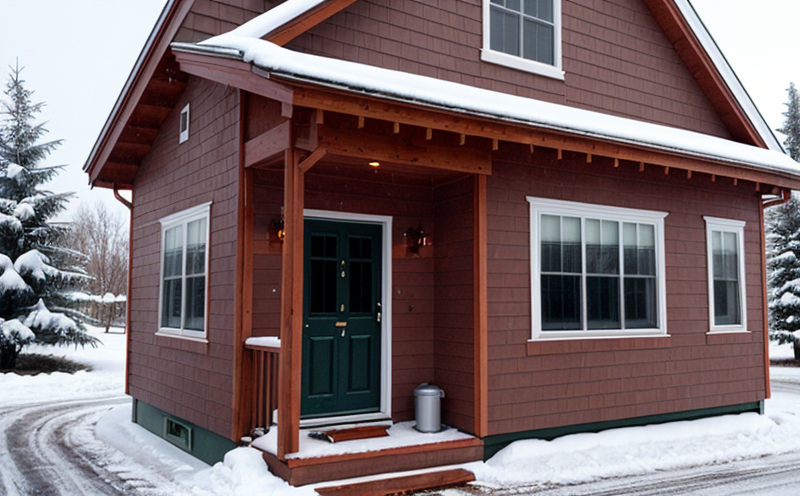ISO 7730 Seasonal Thermal Comfort Assessment
The ISO 7730 standard provides a method for assessing thermal comfort in buildings. This assessment is crucial for ensuring that HVAC systems deliver the required level of thermal comfort and energy efficiency throughout the seasons. The seasonal thermal comfort assessment evaluates how well an HVAC system meets the thermal comfort requirements specified by ISO 7730, which are based on the Predicted Mean Vote (PMV) and Predicted Percentage of Dissatisfied (PPD).
The PMV is a measure of how warm or cold people feel in a space. PPD indicates the proportion of occupants who would be dissatisfied with the thermal environment. These parameters are influenced by factors such as air temperature, humidity, air movement, and radiant heat.
Understanding these factors and their impact on thermal comfort is essential for HVAC system design and operation. The seasonal assessment provides a comprehensive evaluation that helps ensure compliance with international standards. This not only enhances occupant satisfaction but also improves energy efficiency by optimizing the system's performance during different seasons.
The process involves measuring environmental parameters over several days under controlled conditions to simulate real-world scenarios. These measurements are then used to calculate PMV and PPD values, which are compared against acceptable ranges specified in ISO 7730. This allows for identifying any deficiencies in the HVAC system that could lead to discomfort or energy wastage.
By conducting a seasonal thermal comfort assessment, organizations can ensure they meet regulatory requirements while also improving their reputation by demonstrating a commitment to sustainability and occupant well-being.
- Identifies deficiencies in HVAC systems leading to discomfort
- Ensures compliance with international standards
- Improves energy efficiency of HVAC systems
- Enhances occupant satisfaction
The assessment also helps organizations stay ahead of regulatory changes and industry trends. As environmental regulations evolve, understanding the impact on thermal comfort is crucial for maintaining compliance.
In summary, ISO 7730 seasonal thermal comfort assessments provide a robust framework for evaluating HVAC systems' performance in relation to occupant comfort and energy efficiency. This service ensures that organizations can meet regulatory requirements while also enhancing their operational efficiency and sustainability practices.
Why It Matters
The importance of thermal comfort assessment cannot be overstated, especially within the HVAC industry. Occupants' well-being is directly linked to the quality of indoor environments, which in turn impacts productivity, health, and overall satisfaction. A comfortable environment reduces stress levels and enhances cognitive function, leading to better work performance.
From an energy efficiency standpoint, maintaining thermal comfort can significantly reduce energy consumption by optimizing HVAC system operations. Efficient systems not only lower utility costs but also contribute positively to environmental sustainability goals. By aligning with international standards like ISO 7730, organizations demonstrate their commitment to both operational excellence and sustainable practices.
The seasonal aspect of this assessment is particularly relevant because it takes into account the varying conditions throughout different seasons. This ensures that HVAC systems are not only effective during typical operating conditions but also resilient enough to handle extreme weather events without compromising comfort or energy efficiency.
Moreover, compliance with such standards can provide a competitive edge in the market by positioning organizations as leaders in sustainability and occupant care. It also offers peace of mind for stakeholders who rely on accurate data for decision-making processes related to facility management and maintenance.
Eurolab Advantages
EuroLab's expertise in HVAC equipment testing sets us apart as a premier choice for ISO 7730 seasonal thermal comfort assessments. Our team of experienced engineers combines technical knowledge with practical experience to deliver accurate and reliable results every time.
We employ advanced instrumentation and software solutions that ensure precise measurements under controlled conditions, allowing for comprehensive evaluations of HVAC systems' performance. This precision is critical when it comes to meeting the stringent requirements set forth by ISO 7730.
Our commitment to quality extends beyond just conducting assessments; we also offer detailed reports that provide actionable insights into system improvements needed to enhance thermal comfort and energy efficiency. These reports are tailored specifically for your organization's needs, ensuring they are both informative and easily understandable.
In addition to our technical capabilities, EuroLab offers unparalleled customer service and support throughout the entire process—from initial consultation through final report delivery. Our goal is not only to meet but exceed expectations by providing personalized attention and solutions that truly add value.
Why Choose This Test
- Precise Measurement: Utilizes advanced instrumentation for accurate data collection under controlled conditions.
- Comprehensive Evaluation: Considers multiple factors including air temperature, humidity, airflow rates, and radiant heat.
- Standard Compliance: Ensures strict adherence to ISO 7730 guidelines for thermal comfort assessment.
- Actionable Insights: Provides detailed reports with specific recommendations for system improvements.
- Customer Focus: Offers personalized attention and support from start to finish, ensuring customer satisfaction.
- Sustainability Impact: Helps reduce energy consumption while enhancing occupant comfort and health.
Selecting the right thermal comfort assessment is essential for achieving optimal results. EuroLab's ISO 7730 seasonal thermal comfort assessments stand out because they offer more than just compliance; they provide valuable insights that can lead to significant improvements in HVAC system performance and overall building efficiency.





